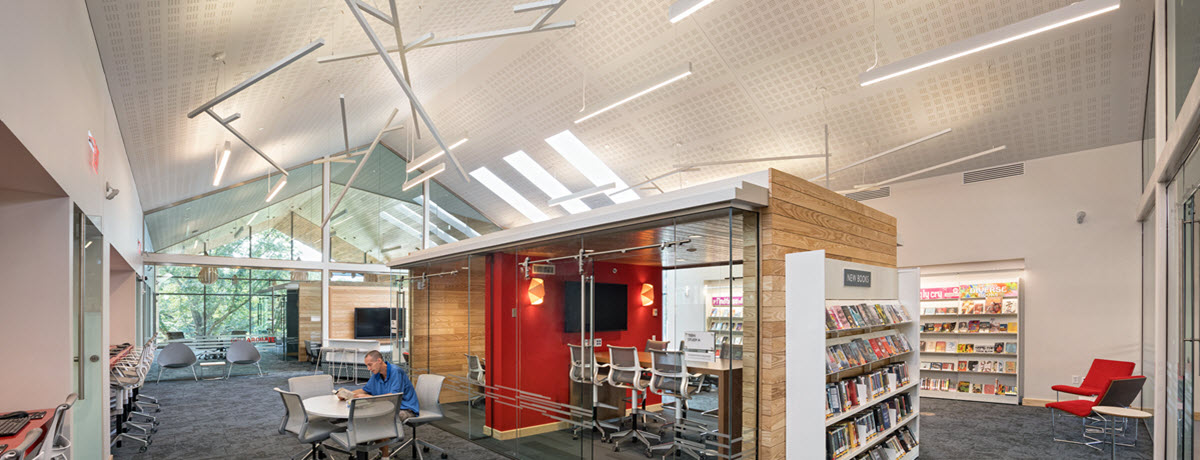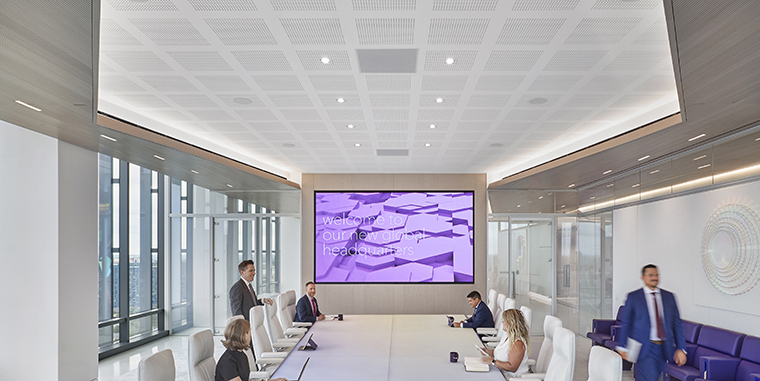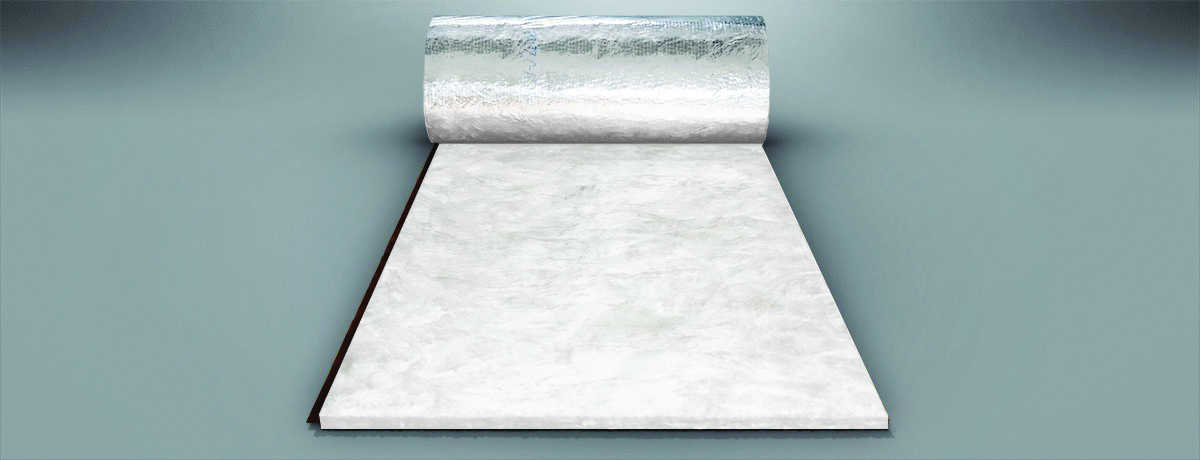June 01, 2021
ACHIEVING AND MAINTAINING HEALTHY IAQ IN COMMERCIAL REAL ESTATE

Philadelphia’s first vertical neighborhood, the FMC Tower, has an interior full of CertainTeed products, providing natural light and strong acoustical design. Photograph taken by Khairil Azhar Junos.
Ensuring good indoor air quality (IAQ) is an important task for owners, architects, construction professionals, and facility managers today. The impact it has on the sustainability of a building, as well as on the health of its occupants, is significant. Even after the coronavirus public health emergency passes, IAQ will be a key component to delivering and managing healthy and desirable commercial investments. Based on research done over the years, several national public health and environmental organizations, such as the U.S. Environmental Protection Agency (EPA), American Lung Association (ALA), and the American College of Allergy, Asthma & Immunology (ACAAI), view indoor air pollution as one of the greatest risks to human health. One study commissioned by the ACAAI revealed that 50 percent of all respiratory illnesses are either caused or aggravated by poor IAQ.
Fortunately, IAQ problems can largely be avoided through periodic preventative maintenance and smart choices in building design, material selection, finishes, furnishings, and cleaning products. First, though, it’s important to understand common sources of indoor air pollution.
IAQ Threats
There are several IAQ threats found in the average building, arising from a variety of sources. The Covid-19 pandemic made it clear how airborne pathogens can spread throughout enclosed spaces to disastrous effect. However, when it comes to walls, ceilings and HVAC systems, the next most serious potential pollutants are mold and volatile organic compounds (VOCs).
Mold forms when tiny mold spores make contact with surfaces made from organic materials, such as wood or paper. The surfaces often become damp as a result of roof and plumbing leaks or uncontrolled condensation. When there is an outbreak of mold in a building, occupants may begin to report odors and various health problems, such as headaches, breathing difficulties, skin irritation, allergic reactions, and aggravation of asthma symptoms.
Mold can also grow inside uninsulated HVAC sheet metal ductwork if it’s not sufficiently sealed or maintained over time. During the summer, warm, uninsulated ducts located in unconditioned areas of buildings tend to sweat as cold air travels through them. Conversely, during winter, low temperatures can cause condensation as heated air travels through cold ducts. Unfortunately, this condensed moisture sometimes mixes with dust or dirt present in ducts to eventually spawn mold growth. Since the HVAC system distributes air throughout the building, this can create a serious IAQ problem if left unattended.

Varina Library in Richmond, VA features CertainTeed Gyptone® BIG™ Perforated panels,used for their unique ceiling design and their ability to capture VOCs.
VOCs are gases or vapors--such as formaldehyde--that can negatively affect the health of building occupants. They are emitted from various solids and liquids--such as paints and lacquers, paint strippers, building materials, furnishings, cleaning supplies, and pesticides--that somehow incorporate organic chemicals into their manufacturing process. All products manufactured with organic chemicals have potential for releasing VOCs while in use.
Now that we’ve gone over the sources of poor IAQ, we can look at the various ways of eliminating them.
Reduce Pathogen Spread
Whether deadly viruses, colds, or the flu, your spaces can reduce the impact of these pathogens and be much healthier by paying close attention to three vital interventions: ventilation, filtration & mixing, plus air cleaning. These same things can be said for VOCs.
American Society of Heating, Refrigerating and Air-Conditioning Engineers (ASHRAE) Core Recommendations for Reducing Airborne Infectious Aerosol Exposure states that spaces must have at least the minimum code-required rates of outdoor airflow. Rates can vary by building use and location, but typically offices will need between 2-4 air changes per hour (ACH). Air moving through HVAC systems should be filtered with MERV 13 level filtration performance or better. Within the HVAC system’s return, ducting is an ideal location to plan for or add UVC light-based air cleaners. Where air is not being properly distributed in occupied spaces, fans can be added to mix air without causing strong currents. In addition to designing overhead valences and light shelves to disguise UVC fixtures, some ceiling fans now also come with UVC air cleaning capabilities. Of course, reducing pathogen spread also requires a well-sized, well-maintained HVAC system (more on that below) that will reliably provide the temperature and humidity settings that do not promote spread and poor IAQ.

Leidos Headquarters in Reston, VA featuring CertainTeed Gyptone® BIG™ Perforated panels. The panels create a unique ceiling and wall design as they capture VOCs.
Mold Prevention
Mold prevention starts with a durable, resilient building envelope design and construction. High-performance buildings require roof and wall assemblies that are built to withstand the specific climate and operational demands so that bulk and vapor moisture intrusion does not ruin an investment and contribute to poor IAQ. A hygrothermal analysis is one method that building science experts use to predict how buildings might perform by using software programs to evaluate building envelopes against climate and weather data for a specific location and is a great safeguard for reducing the risk of poor IAQ in the future.
However, once a building is in place, in addition to repairing plumbing and roof leaks as they arise, there are two key periodic maintenance tasks that will help keep interior air mold-free.
Seal and Insulate Ductwork
Most HVAC system specs for commercial buildings include well-sealed, insulated ducts — made sufficiently airtight — to minimize the amount of heat loss in the winter and cool air leakage in the summer. Leaks in supply ducts reduce the delivered volumes of air at diffusers and registers, leading building managers to increase the total amount of supply air to compensate for the losses, requiring more energy use than designed. Leaks in return ducts, however, not only reduce the system’s thermal efficiency, but they can also draw pollutants into the ductwork, which will carry them into the interior air supply. Sealing and insulating ducts not only helps ensure optimal energy efficiency and shielding from air pollutants, but also maintains the constant temperature needed to prevent the duct condensation that can spawn mold and microbe growth.
If a building’s ductwork is uninsulated, fiberglass duct wrap, such as CertainTeed SoftTouch™ fiberglass duct wrap, can be installed over sealed ducts to provide improved thermal performance and occupant comfort. At the very minimum, make sure that ductwork is wrapped in all unconditioned areas. Quality fiberglass duct insulation and joint caulking will only get you so far, though. To keep the flow of conditioned air clean, periodic HVAC system maintenance is recommended.
HVAC System Maintenance
To ensure ductwork stays mold-free, it is wise to schedule periodic inspections to verify that the HVAC system is clean and in working order. High-efficiency air filters of the correct size and MERV 13 quality are key components of a well-maintained HVAC system and should be changed every two to three months. Ducts, too, should be regularly inspected for the detection of dust and other debris, as well as mold and other contaminants. If mold growth is found in sheet metal ductwork, the surface must be cleaned in compliance with the National Air Duct Cleaning Association (NADCA) which requires the use of mechanical agitation methods to remove particulate, debris, nutrient sources and surface contamination. Avoid using any liquid or spray cleaners, including biocides.
The most effective method for cleaning ductwork is air sweeping, which introduces compressed air into the duct through a hose capped with a skipper nozzle. The compressed air propels the nozzle through the ductwork, dislodging dirt, dust, and debris along the way. The dislodged particles are drawn downstream through the duct and out of the system.

SoftTouch™ Duct Wrap acts as a thermal blanket as well as a vapor retarder, preventing condensation from forming.
VOC Reduction
These days, there are several opportunities to significantly reduce the level of VOCs in indoor air by making the right building materials choices during new construction and renovation projects, as well as when selecting paints, finishes, carpeting, and furniture. For best results, make sure all are certified “low-VOC” products, with little or no VOC content. In addition, building maintenance and housekeeping staff should use only low-VOC cleaning supplies, pesticides, and air fresheners inside the building. Most manufacturers have worked hard in recent years to reduce the VOC emissions of their products to very low levels.
However, it is still important to check individual product data to be certain. Certification from the GREENGUARD Environmental Institute is one resource for determining if a product's VOC content is within acceptable limits.
One of the newest innovations for reducing the VOC content of interior air with building products is the concept of VOC sequestration. This involves incorporating patented technology from CertainTeed Corporation and parent company Saint-Gobain into the manufacturers’ interior products, such as Saint-Gobain’s Novelio Clean Air fiberglass wall covering or CertainTeed Architectural’s Gyptone ceiling and wall panels.
These products capture VOCs — especially formaldehyde — as they circulate through interior air and convert them into inert compounds that remain within the product, unable to be released back into the air. The products will also continue to remove any additional VOC content introduced into the interior space over time by new carpeting, furniture, and finishes.
In Closing
Indoor air pollution is a threat to the health of building occupants, as well as a building’s sustainability. If acceptable IAQ levels are maintained in buildings, the result will be a comfortable, healthy interior environment for many years to come. Being proactive as an owner, architect, and facility manager and preventing any threats to the IAQ of a facility truly benefits all parties involved.
To learn more about how Saint-Gobain Commercial Solutions helps our strategic clients achieve spaces with superior IAQ and overall success with their CRE investments, request an introductory consultation here.
 SAINT-GOBAIN main website
SAINT-GOBAIN main website